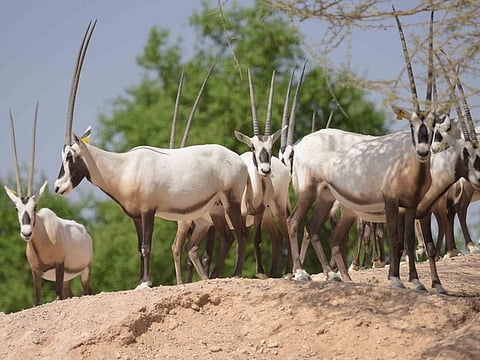Watch: How UAE brought Arabian oryx back from the brink of extinction
In a testimony to conservation, UAE now boasts world’s largest population of Arabian oryx

Abu Dhabi: The Arabian oryx is the national animal of the UAE. Once on the brink of extinction, it’s a remarkable symbol of the country’s conservation efforts.
Historically abundant across the Arabian Peninsula, the Arabian oryx faced severe decline due to overhunting. By the early 1970s, the species was nearly eradicated from the wild.
However, visionary conservation initiatives spearheaded by the UAE’s Founding Father, the late Sheikh Zayed bin Sultan Al Nahyan, established a breeding programme in Al Ain, which later expanded to Sir Bani Yas Island in Abu Dhabi.
Fast forward to today, and the results of these efforts are nothing short of astounding.
In 2023, the UAE’s Arabian oryx population reached 8,016, with 5,679 thriving in Abu Dhabi, both in captivity and in the wild.
Today, the UAE is home to the largest population of Arabian oryx in the world, according to the Ministry of Climate Change and Environment.
Unique adaptations
The ministry said the Arabian oryx can track rainfall and new plant growth up to 90km away.
Male bucks have thicker, shorter horns than female does. The young lamb stand and walk within an hour of birth. While the adults are mostly white in colour, the lambs are light brown.
The species predominantly inhabit the Qasr Al Sarab and Arabian Oryx Reserves in Abu Dhabi.
Conservation efforts
The UAE’s success in preserving endangered species is underpinned by robust legislation and adherence to international agreements.
Desert survivor’s key features
Appearance: Medium-sized with a distinctive shoulder hump, long straight horns, and a tufted tail. Adults weigh up to 80kg. Habitat: Native to the arid deserts and steppes of the Arabian Peninsula. Adaptations: They have broad hooves for navigating san, can detect rainfall and fresh plant growth from up to 90km away and have a unique circulation system in their head to help them stay cool. After being born, the baby can stand and walk in just an hour. Conservation status: While once extinct in the wild, it’s now classified as Vulnerable, thanks to successful reintroduction programmes. Threats: Historically, hunting and habitat loss were the primary threats.
The country has several laws to protect its biodiversity such as the Federal Law 23 and 24 of 1999. While the former regulates exploitation, protection and development of living aquatic resources and the latter prohibits hunting, transporting, killing or harming wild or marine organisms or carrying out acts that would eliminate them.
The country is also a signatory to conventions such as Convention on International Trade in Endangered Species of Flora and Fauna (CITES), the Convention on Biological Diversity, the Ramsar Convention, and the Convention on the Conservation of Wildlife in GCC countries.
In 2022, the Ministry of Climate Change and Environment launched the National Red List of Threatened Species, assessing the status of local species and reinforcing the UAE’s proactive approach to biodiversity conservation. The Arabian oryx’s recovery is a testament to these efforts, reflecting the UAE’s commitment to protecting its natural heritage.
Sign up for the Daily Briefing
Get the latest news and updates straight to your inbox


